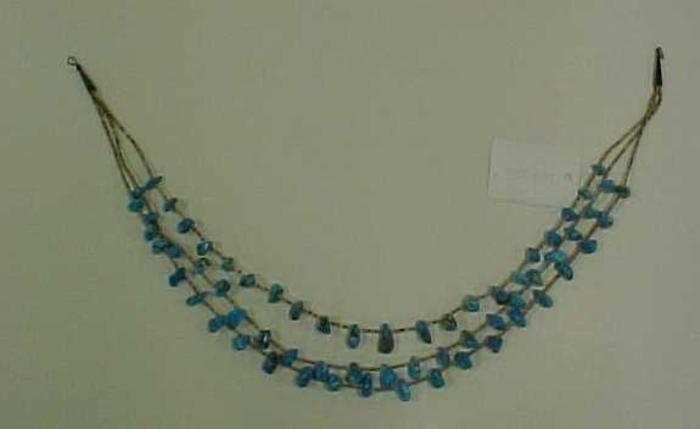Comments and Tags
Be the first to comment on this item!
Native American
Native American - Southwest ➔ Turquoise Necklace
Identifier:
2003.22.2Description:
Three strands of roughly-shaped turqoise nuggets spaced with of shell beads.This necklace belonged to Dr. Dwight Schroeder, a physician who treated Native Americans in the Sutton's Bay area for free and/or reduced fees. He saw the poverty of their circumstances and believed that a renaissance of traditional Indian culture would benefit the community. He helped organize and finance the first annual Leelanau Pow-wow in 1971, and was given the honorary title of "Mush-ke-ke-anena" (Medicine Man) in 1972. He was also given a beaded dance outfit and other traditional Woodland Indian art objects in gratitude for his contributions to the Indian community. It may have been a gift from one of his patients.
This necklace reflects the craftsmanship of the Native Americans in the southwest and their contribution to the turquoise trade. Southwestern Native Americans specifically the Zuni pueblo and Hopi held the turquoise stone as sacred. The sanctity of the stone came from its various purposes: medicinal, spiritual and ascetic. The stone was said to be an opening between the sea and the sky. Mythological stories of both the Zuni and Hopi tribes are centered around the gems healing properties. The gem’s medicinal qualities have been thought to prevent illness and disease and were important for the medicine man to wear. In additional to healing purposes: necklaces, rings and bracelets provided creative embellishments to simple metals. Until the Spanish came in the 1800’s many tribes didn’t use silver in their jewelry but used readily available materials such as copper. The addition of silver allowed for a more ornate and complex jewelry designs.
This artifact shows a simpler and traditional design pre-dating the Spanish trade. This necklace could have arrived in Michigan through trade between Native Tribes or contact with Spanish settlers. The piece displays the raw and natural beauty of turquoise in its purest form.
Turquoise is a gemstone that can be found in arid parts of the world. The gem is specifically mined in the southwestern part of the U.S and has been traced back to Ancient Egypt. The color in the gem can be attributed to the arid conditions that make the soil rich in copper, iron and chrome. Copper causes the blue tint while the green is causes by a combination of chrome and iron particles. These combinations of colors in addition to the indentations and lines throughout make the turquoise, such a unique stone. The root word of turquoise comes from France and translates as “Turkish stone” since Europeans traded with Turkey to acquire gems, though Turkey didn’t have any Turquoise mines. Turquoise is a gem valued for it’s unique color as well as its intricate and masterful design in the world of jewelry.
